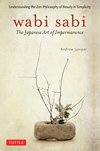
Saved by Lael Johnson and
Wabi Sabi: The Japanese Art of Impermanence

Saved by Lael Johnson and
Raku-style pottery was incorporated into the tea ceremony as a reaction to the ornate Chinese utensils adopted by the nobility and emphasized the beauty of rustic imperfection over attempts at perfection. It was during this period that, under the guidance of the tea masters, Japan’s artistry moved into a new era with the appreciation of things wabi
... See moreIn reality there is nothing in the universe which is completely perfect or completely still; it is only in the minds of men that such concepts exist.” —Alan Watts
the Japanese seek to harness the emotive effect of death to add force and power to their actions. With this force also comes a sense of inconsolable desolation, and it is this feeling to which the term sabi is often applied.
The rikka style, which means standing flower, was more sophisticated than the Buddhist offerings and more formal in its rules. There were seven branches symbolizing the peak, the hill, the waterfall, the town, the valley, the side receiving sunlight, and the side in the shade. It was built around the Buddhist cosmic view, and because of the
... See moreperhaps one could define the four tenets of wabi sabi as follows: Everything in the universe is in flux, coming from or returning to nothing. Wabi sabi art is able to embody and suggest this essential truism of impermanence. Experiencing wabi sabi expressions can engender a peaceful contemplation of the transience of all things. By appreciating
... See moreIt offers an aesthetic ideal that uses the uncompromising touch of mortality to focus the mind on the exquisite transient beauty to be found in all things impermanent. It can be found in the arrangement of a single flower, the expression of profound emotion in three lines of poetry, or in the perception of a mountain landscape in a single rock.
a defining feature of later wabi sabi designs.
Rakuware, which later became synonymous with tea utensils, was in fact first commissioned by Rikyu after he noticed the visual qualities of a locally made roof tile. He asked the tile maker, Chojiro, to fashion pots using the same low-fired technique. Years later, Hideyoshi gave this style his approval by awarding a gold seal to Chojiro’s son with
... See moreAlthough one can get a feeling of wabi sabi from naturally occurring phenomena, it is usually the act of framing by an artist that brings the poignancy to the attention of others.